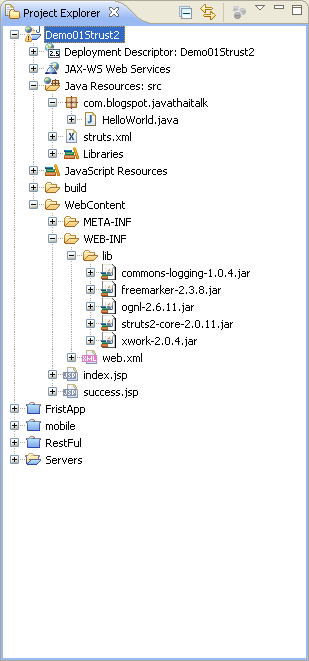Table 1. Sample Table
| Annotation | Description |
|---|---|
| @PATH(your_path) | Sets the path to base URL + /your_path. The base URL is based on your application name, the servlet and the URL pattern from the web.xml" configuration file. |
| @POST | Indicates that the following method will answer to a HTTP POST request |
| @GET | Indicates that the following method will answer to a HTTP GET request |
| @PUT | Indicates that the following method will answer to a HTTP PUT request |
| @DELETE | Indicates that the following method will answer to a HTTP DELETE request |
| @Produces( MediaType.TEXT_PLAIN [, more-types ] ) | @Produces defines which MIME type is delivered by a method annotated with @GET. In the example text ("text/plain" ) is produced. Other examples would be "application/xml" or "application/json". |
| @Consumes( type [, more-types ] ) | @Consumes defines which MIME type is consumed by this method. |
| @PathParam | Used to inject values from the URL into a method parameter. This way you inject for example the ID of a resource into the method to get the correct object. |
The complete path to a resource is therefore based on the base URL and the @PATh annotation in your class.
http://your_domain:port/display-name/url-pattern/path_from_rest_class
Tools ที่เราใช้ประกอบไปด้วย
1. Eclipse Helios
2. Tomcat 6.0
1.Create Java Web Dynamic


library ทั้งหมดที่เกี่ยวข้อง
cccc
1.Domain
package com.blogspot.javathaitalk.domain;
public class Track {
String title;
String singer;
public String getTitle() {
return title;
}
public void setTitle(String title) {
this.title = title;
}
public String getSinger() {
return singer;
}
public void setSinger(String singer) {
this.singer = singer;
}
@Override
public String toString() {
return "Track [title=" + title + ", singer=" + singer + "]";
}
}
2.Java Class Service
package com.blogspot.javathaitalk.webservices.rest;
import javax.ws.rs.Consumes;
import javax.ws.rs.GET;
import javax.ws.rs.POST;
import javax.ws.rs.Path;
import javax.ws.rs.Produces;
import javax.ws.rs.core.MediaType;
import javax.ws.rs.core.Response;
import com.blogspot.javathaitalk.domain.Track;
@Path("/json/metallica")
public class JSONService {
@GET
@Path("/get")
@Produces(MediaType.APPLICATION_JSON)
public Track getTrackInJSON() {
Track track = new Track();
track.setTitle("Enter Sandman");
track.setSinger("Metallica");
return track;
}
@POST
@Path("/post")
@Consumes(MediaType.APPLICATION_JSON)
public Response createTrackInJSON(Track track) {
String result = "Track saved : " + track;
return Response.status(201).entity(result).build();
}
}
3.Jersey Client Get
package com.blogspot.javathaitalk.webservices.client;
import com.sun.jersey.api.client.Client;
import com.sun.jersey.api.client.ClientResponse;
import com.sun.jersey.api.client.WebResource;
public class JerseyClientGet {
public static void main(String[] args) {
try {
Client client = Client.create();
WebResource webResource = client.resource("http://localhost:8080/DemoRESTfulExample/rest/json/metallica/get");
ClientResponse response = webResource.accept("application/json")
.get(ClientResponse.class);
if (response.getStatus() != 200) {
throw new RuntimeException("Failed : HTTP error code : "
+ response.getStatus());
}
String output = response.getEntity(String.class);
System.out.println("Output from Server .... \n");
System.out.println(output);
} catch (Exception e) {
e.printStackTrace();
}
}
}
4.Jersey Client Post
package com.blogspot.javathaitalk.webservices.client;
import com.sun.jersey.api.client.Client;
import com.sun.jersey.api.client.ClientResponse;
import com.sun.jersey.api.client.WebResource;
public class JerseyClientPost {
public static void main(String[] args) {
try {
Client client = Client.create();
WebResource webResource = client
.resource("http://localhost:8080/DemoRESTfulExample/rest/json/metallica/post");
String input = "{\"singer\":\"Metallica\",\"title\":\"Fade To Black\"}";
ClientResponse response = webResource.type("application/json")
.post(ClientResponse.class, input);
if (response.getStatus() != 201) {
throw new RuntimeException("Failed : HTTP error code : "
+ response.getStatus());
}
System.out.println("Output from Server .... \n");
String output = response.getEntity(String.class);
System.out.println(output);
} catch (Exception e) {
e.printStackTrace();
}
}
}
5.Define Jersey Servlet dispatcher
<?xml version="1.0" encoding="UTF-8"?>
<web-app xmlns:xsi="http://www.w3.org/2001/XMLSchema-instance" xmlns="http://java.sun.com/xml/ns/javaee" xmlns:web="http://java.sun.com/xml/ns/javaee/web-app_2_5.xsd" xsi:schemaLocation="http://java.sun.com/xml/ns/javaee http://java.sun.com/xml/ns/javaee/web-app_2_5.xsd" id="WebApp_ID" version="2.5">
<display-name>DemoRESTfulExample</display-name>
<welcome-file-list>
<welcome-file>index.jsp</welcome-file>
</welcome-file-list>
<servlet>
<servlet-name>jersey-serlvet</servlet-name>
<servlet-class>com.sun.jersey.spi.container.servlet.ServletContainer</servlet-class>
<init-param>
<param-name>com.sun.jersey.config.property.packages</param-name>
<param-value>com.blogspot.javathaitalk.webservices.rest</param-value>
</init-param>
<init-param>
<param-name>com.sun.jersey.api.json.POJOMappingFeature</param-name>
<param-value>true</param-value>
</init-param>
<load-on-startup>1</load-on-startup>
</servlet>
<servlet-mapping>
<servlet-name>jersey-serlvet</servlet-name>
<url-pattern>/rest/*</url-pattern>
</servlet-mapping>
</web-app>
สำหรับการทดสอบ Webservice ให้ทำการ Run Java Web ก่อน แล้วค่อยไปเรียกทดสอบ Client แบบ java App ธรรมดาทีหลัง
1.ทดสอบ เรียกผ่าน URL ด้วย Get Method
2.ทดสอบเรียกผ่าน JerseyClientGet Class
3.ทดสอบเรียกผ่าน JerseyClientPost Class
*ปล. ถ้าใครอยากได้ SourceCode ให้ Comment ไว้นะครับ เดี๋ยวผมจะส่งให้ทาง Email.





